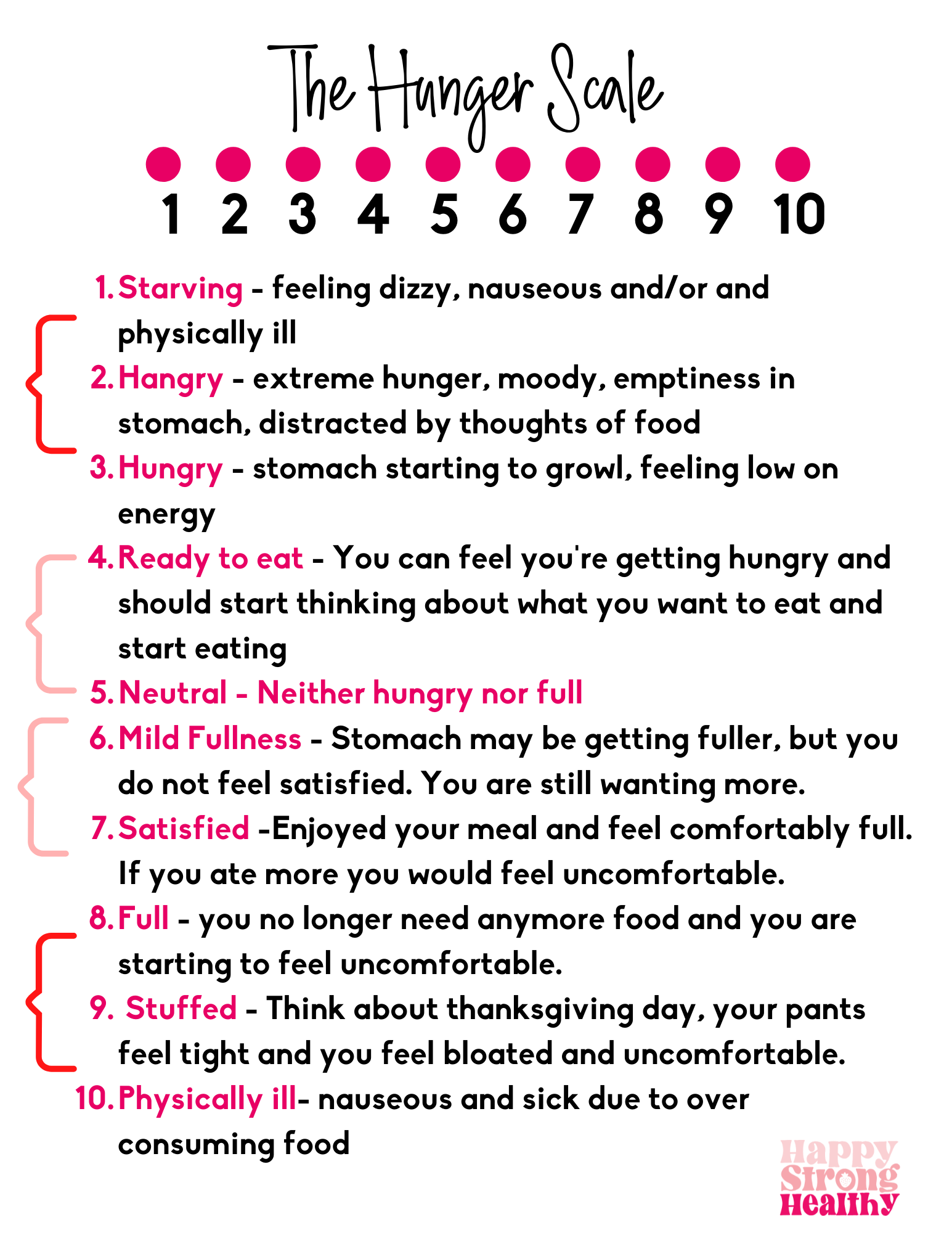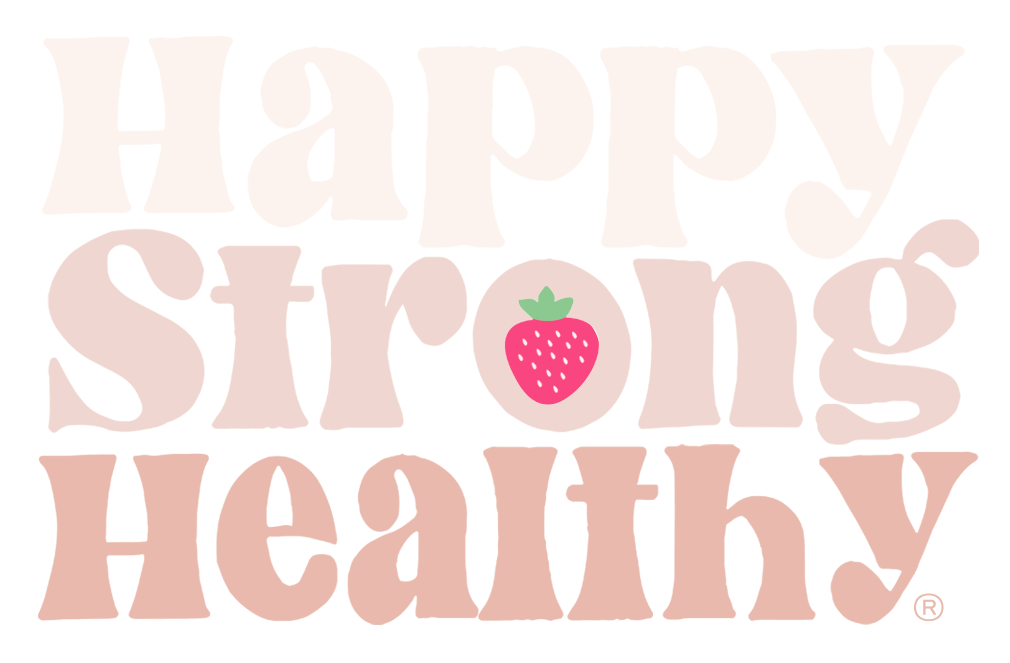How To Identify Hunger

Our bodies are smart and sometimes we do not give them the credit they deserve. Our bodies tell us when we are in pain, when we need to use the restroom, when someone touches us, and yes when we are hungry and full. These cues can be suppressed by diets and negative things people say to us around food. The good news is we can get back in touch with these feelings and fuel our bodies the way they are intended by listening in.
To start tuning in we need to ask ourselves questions throughout the day. When you are in-between meals, you can ask “Do I feel as though I will be ready to eat before my next meal?” if so, grab a snack. During your meal check in halfway through to assess, “Am I still hungry or am I starting to feel satisfied?” These questions may seem simple, but they allow us to pause in our busy lives and check in with ourselves so that we can allow our intuition to kick in with fullness and hunger cues.
If at first you have trouble determining if you’re hungry, aim to eat every 3 hours. If you’ve gone hours and hours without eating in the past, your body has learned to dull your hunger cues. This interval will help get them fired up again!
Physical hunger feels like your stomach rumbling or gnawing. Other signs can be difficulty focusing, lightheadedness, irritability, low energy, and a dull ache in your throat. These are just a few of the signs your body may be trying to communicate that its ready for food.
There are other types of hunger. Keep in mind that each of these is a legitimate reason to eat.
Eye & Nose Hunger: You see or smell something and your body says “yes, please”
Mind Hunger: When it just makes sense to eat at a certain time or because of stressful feelings
Heart Hunger: These are the foods that we eat with or remind us of those we care about. This can also be from an unmet need. Many people refer to this as emotional hunger.
When assessing your hunger level, a hunger and fullness scale can be a great tool. Staying ahead of our hunger is a great way to care for our body well. So instead of waiting until you are hangry to eat, respect your body earlier on by eating when your body is ready to eat. The chart below can help you categorize where you are on the scale. We like people to stay between hungry and satisfied.
Starving - feeling dizzy, nauseous and/or and physically ill
Hangry - extreme hunger, moody, emptiness in stomach, distracted by thoughts of food
Hungry - stomach starting to growl, feeling low on energy
Ready to eat - You can feel you're getting hungry and should start thinking about what you want to eat and start eating
Neutral - Neither hungry nor full
Mild Fullness - Stomach may be getting fuller, but you do not feel satisfied. You are still wanting more.
Satisfied -Enjoyed your meal and feel comfortably full. If you ate more you would feel uncomfortable.
Full - you no longer need anymore food and you are starting to feel uncomfortable.
Stuffed - Think about thanksgiving day, your pants feel tight and you feel bloated and uncomfortable.
Physically ill- nauseous and sick due to over consuming food

Some may need help identifying their hunger and fullness and that is okay! We are here to walk alongside you in this journey! We would love to chat with you about how food freedom is possible. Reach out to us!

Written by Rachel Bailey
Hi, I’m Rachel!
I am a dietetic student that loves all things nutrition! I found intuitive eating about a year ago and want to shout food freedom from the rooftops! HSH was a resource for me and I know it will bring benefit to your journey as well.
Learn more about me and the HSH offerings here.
Every January, the internet explodes with “fix your body” energy. And every January, I want to gently remind people of something important: Your health does not reset on January 1st, but your habits can evolve. Here is what I would do if I was you.
Confused about seed oils? You should be! Wellness influencers saw an opportunity to incite fear and increase engagement by cherry picking data and ran with it. And it worked. But what is fact and what is just simply fear? Let’s clear some stuff up so you can make informed decisions that are best for you.

February is American Heart Month, and as a registered dietitian, I want to share my secret heart-healthy tip with you: consider adding Florida Orange Juice to your daily routine!
Discover 9 must-have cookbooks for your kitchen, from quick one-pan meals to family-friendly recipes. Perfect for busy cooks, these cookbooks offer simple, delicious solutions for everyday cooking, meal prep, and entertaining.
Expert guide to protein supplements: Learn when to take them, how much you need, and which type is best for your fitness goals. Discover the differences between whey and casein, optimal timing, and quality considerations from registered dietitians.
Discover the science-backed relationship between diet and sleep quality. Learn how macronutrients, micronutrients, and meal timing impact your sleep, plus practical tips for better rest through nutrition. Expert insights from registered dietitians.
Transform ordinary carrots into a showstopping Thanksgiving side dish with this easy brown sugar glazed carrots recipe. Learn how to make this kid-friendly, nutrient-rich vegetable dish that combines sweetness with savory herbs.
Discover 7 creative and protein-packed cottage cheese recipes from a registered dietitian. Learn how to make cookie dough, lasagna, queso, and more using this versatile ingredient. Elevate your meals with these easy, nutritious cottage cheese ideas.
Discover why cortisol isn't the enemy and learn 5 effective, natural strategies to manage stress without supplements. Our registered dietitian's guide explores sleep, mindful eating, balanced movement, stress management tactics, and alcohol alternatives for holistic well-being.
Elevate your at-home date night with our easy, nutrient-packed charcuterie board for two. Learn how to assemble a romantic spread using Trader Joe's ingredients, balancing protein, fats, carbs, and fiber. Perfect for couples looking for a fun, flavorful, and intimate dining experience.
Discover the truth about BCAA supplements from a registered dietitian. Learn what BCAAs are, how they compare to other amino acids, and whether you should include them in your fitness routine. Get evidence-based answers to the most common BCAA questions and make informed decisions about your nutrition.
Discover a delicious and nutritious Caprese White Bean Salad recipe perfect for meal prep, quick dinners, or summer gatherings. Packed with protein, fiber, and healthy fats, this versatile dish can be served over pasta, romaine, or enjoyed on its own. Learn how to make this easy, flavorful salad in minutes!
Discover the truth about creatine supplements from a registered dietitian. Learn the differences between creatine monohydrate and micronized creatine, who can benefit from supplementation, and get answers to common questions. Explore the latest research on creatine's effects on muscle growth, brain health, and more.
Discover the truth about pizza's nutritional value from a registered dietitian. Learn how to enjoy pizza guilt-free, balance it with side salads, and compare frozen pizza options. Debunk diet culture myths and embrace intuitive eating with our expert insights.
Discover a quick and satisfying Air Fryer Brunch Toast recipe. Perfect for busy mornings or pre-travel meals, this delicious and nutritious toast combines sourdough, eggs, avocado, and more. Learn how to make this easy, filling breakfast that'll keep you energized for hours.
Discover the truth behind the mushroom coffee trend. Learn about its history, nutrition facts, potential benefits, and price. Is this wellness craze worth the hype? Find out in our comprehensive blog post
Elevate your morning routine with our delicious and easy-to-make breakfast taco recipe. This dietitian-approved dish features a flavorful combination of scrambled eggs, black beans, avocado, and zesty seasonings, all wrapped in warm tortillas. Perfect for busy mornings or weekend brunch, this recipe will become your new go-to breakfast favorite. Learn how to make this mouthwatering meal in just 25 minutes!
Learn about the popular diabetic weight loss drugs, GLP-1's and SGLT-2's, and how they work to help with weight loss and lowering A1C levels. Discover the potential side effects and considerations before starting these medications. Get informed with our comprehensive guide on diabetic weight loss drugs.
Discover the #morningglowmocktail, a delicious and sleep-enhancing drink featuring tart cherry juice, a natural source of melatonin. Learn how to make this easy mocktail and improve your sleep quality during #bettersleepmonth. #sponsored by Tart Cherry Industry. #ustartcherries
Elevate your spring and summer BBQ menu with this delicious and satisfying Prosciutto Pasta Salad recipe. Packed with roasted red peppers, parmesan cheese, fresh veggies, and a tangy dressing, this easy-to-make dish is perfect for any occasion. Learn how to create this crowd-pleasing pasta salad with our step-by-step guide.
Colostrum, the "liquid gold" supplement, is trending, but is it worth the hype? Learn about the benefits and limitations of bovine colostrum for adults based on current research. Discover the truth behind the marketing claims and make an informed decision about this popular wellness trend.
What’s something that fad diets have that you won’t find here? Well, to be honest, there are many things (LOL) restriction, strict rules, avoiding foods, etc. but the answer in this case is food additions! Nutrition Addition, let’s talk about it!
The sleepy girl mocktail has been making its rounds around TikTok, claiming to help you sleep easier and improve sleep quality. Let’s take a look at the ingredients and see if the talk measures up to the science!
Whether you are going for a run, lifting weights, or an athlete getting ready for a game or race, fueling your body properly is extremely important.
It seems like social media is always looking for ways to tear down or call specific foods bad for you. For the last few years, there have been so many negative articles about seed oils and how “toxic they are”. But are seed oils ACTUALLY bad for you? Let’s talk about it!
Metrics from activity on the app, Strava, expect that up to 80% of people make a resolution and abandon it before the end of January. What if instead of forcing yourself into a box of changes that may or may not be attainable and suitable for your lifestyle, you provided yourself space to grow, breathe, and find ways to better uplift and love yourself?
Many disordered eating behaviors have become so normalized that you might not even realize you are struggling, read on for some common normalized eating behaviors and why they are not normal at all.
As a busy college student, energy bites are a major staple food for me! They come together quickly, freeze well, and are VERY customizable. Packed with fiber and vitamin A, these energy bites are a tasty, no-bake, holiday treat for the whole family.





































